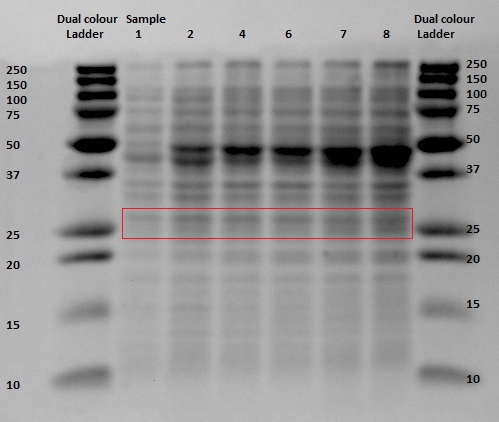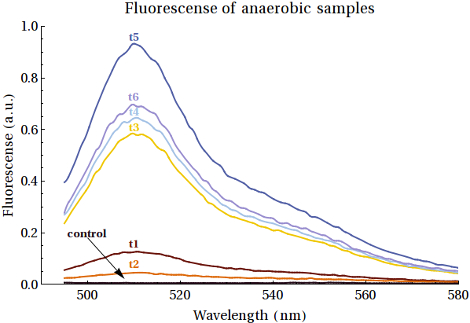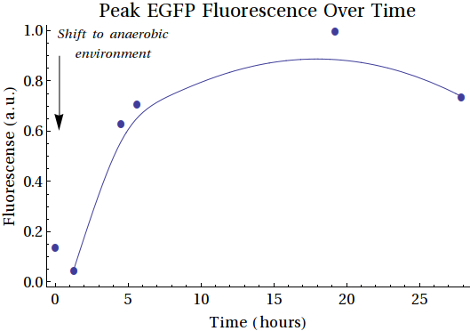Team:TU-Eindhoven/Results
From 2013.igem.org
(→Aerobic Expression) |
Pascalaldo (Talk | contribs) |
||
| Line 1: | Line 1: | ||
{{:Team:TU-Eindhoven/Template:Base}} | {{:Team:TU-Eindhoven/Template:Base}} | ||
{{:Team:TU-Eindhoven/Template:MenuBar}} | {{:Team:TU-Eindhoven/Template:MenuBar}} | ||
| - | === Aerobic Expression | + | =Main Results= |
| + | == Aerobic Expression == | ||
In the experiments for the aerobic expression of the proteins, we have seen that we have produced functional Biobricks. The proteins 1ETF, 1PJN, 1G70 and EGFP were produced aerobically and purified by their His-Tag or exclusion body extraction, so that we can say that the following Biobricks were succesfull: [http://parts.igem.org/Part:BBa_K1123015 BBa_K11230014], [http://parts.igem.org/Part:BBa_K1123015 BBa_K1123015], [http://parts.igem.org/Part:BBa_K1123016 BBa_K1123016] and [http://parts.igem.org/Part:BBa_K1123015 BBa_K1123017]. For more detailed information and further results obtained by these experiments, see [https://2013.igem.org/Team:TU-Eindhoven/CESTAgentTesting CEST Agent Testing]. | In the experiments for the aerobic expression of the proteins, we have seen that we have produced functional Biobricks. The proteins 1ETF, 1PJN, 1G70 and EGFP were produced aerobically and purified by their His-Tag or exclusion body extraction, so that we can say that the following Biobricks were succesfull: [http://parts.igem.org/Part:BBa_K1123015 BBa_K11230014], [http://parts.igem.org/Part:BBa_K1123015 BBa_K1123015], [http://parts.igem.org/Part:BBa_K1123016 BBa_K1123016] and [http://parts.igem.org/Part:BBa_K1123015 BBa_K1123017]. For more detailed information and further results obtained by these experiments, see [https://2013.igem.org/Team:TU-Eindhoven/CESTAgentTesting CEST Agent Testing]. | ||
| - | + | == CEST Agent Testing == | |
| - | + | == Anaerobic FNR Testing == | |
After analyzing the samples taken during anaerobically induced expression of EGFP, we can conclude that the FNR promoter is a functional Biobrick. We can conclude that the EGFP Protein Production Construct is functional too since EGFP was produced. | After analyzing the samples taken during anaerobically induced expression of EGFP, we can conclude that the FNR promoter is a functional Biobrick. We can conclude that the EGFP Protein Production Construct is functional too since EGFP was produced. | ||
{{:Team:TU-Eindhoven/Template:ImageList}} | {{:Team:TU-Eindhoven/Template:ImageList}} | ||
| Line 31: | Line 32: | ||
To see detailed information and results, see [https://2013.igem.org/Team:TU-Eindhoven/AnearobicTesting Anaerobic FNR Testing]. | To see detailed information and results, see [https://2013.igem.org/Team:TU-Eindhoven/AnearobicTesting Anaerobic FNR Testing]. | ||
| - | + | == General Result == | |
As a general result of all the experiments we have a promising CEST contrast Agent and we have a functional FNR promoter, which can be induced anaerobically at 37°C and produces more protein when it is longer exposed to the hypoxic conditions. | As a general result of all the experiments we have a promising CEST contrast Agent and we have a functional FNR promoter, which can be induced anaerobically at 37°C and produces more protein when it is longer exposed to the hypoxic conditions. | ||
Overall, we showed that all the seperate mechanisms are working and that the combined functions are functional too. The proof of concept seems to be promising, but further experiments, such as in vivo experiments and experiments to ensure the killing mechanism is working well, need to be performed to say whether this could really be used for tumor targetting. | Overall, we showed that all the seperate mechanisms are working and that the combined functions are functional too. The proof of concept seems to be promising, but further experiments, such as in vivo experiments and experiments to ensure the killing mechanism is working well, need to be performed to say whether this could really be used for tumor targetting. | ||
Revision as of 20:12, 4 October 2013



Contents |
Main Results
Aerobic Expression
In the experiments for the aerobic expression of the proteins, we have seen that we have produced functional Biobricks. The proteins 1ETF, 1PJN, 1G70 and EGFP were produced aerobically and purified by their His-Tag or exclusion body extraction, so that we can say that the following Biobricks were succesfull: [http://parts.igem.org/Part:BBa_K1123015 BBa_K11230014], [http://parts.igem.org/Part:BBa_K1123015 BBa_K1123015], [http://parts.igem.org/Part:BBa_K1123016 BBa_K1123016] and [http://parts.igem.org/Part:BBa_K1123015 BBa_K1123017]. For more detailed information and further results obtained by these experiments, see CEST Agent Testing.
CEST Agent Testing
Anaerobic FNR Testing
After analyzing the samples taken during anaerobically induced expression of EGFP, we can conclude that the FNR promoter is a functional Biobrick. We can conclude that the EGFP Protein Production Construct is functional too since EGFP was produced.


We performed Fluorescence measurments of the samples taken at different time points during the anaerobically induced expression of EGFP.


General Result
As a general result of all the experiments we have a promising CEST contrast Agent and we have a functional FNR promoter, which can be induced anaerobically at 37°C and produces more protein when it is longer exposed to the hypoxic conditions. Overall, we showed that all the seperate mechanisms are working and that the combined functions are functional too. The proof of concept seems to be promising, but further experiments, such as in vivo experiments and experiments to ensure the killing mechanism is working well, need to be performed to say whether this could really be used for tumor targetting.
 "
"